A General Spectral Difference Method for Calculating the Minimum Safety Distance to Avoid the Pounding of Adjacent Structures during Earthquakes [J]. Engineering Structures. Zhi-wu Yu(余志武) , Han-yun Liu(刘汉云), Wei Guo*(国巍), Qun Liu(刘群) (accepted).
本文的主要研究内容为:With the development of cities, buildings have become increasingly concentrated. Therefore, there are serious potential collision dangers between the adjacent buildings or the building partitions under earthquakes, hence buildings need to set the appropriate safety distance to avoid pounding. However, the calculation of the minimum safety distances (MSD) of the adjacent buildings in Chinese Code is rough and arbitrary, while the traditional response spectrum method is derived based on the assumption of proportional damping and it is difficult to consider the non-proportional damping characteristics for large and complex building systems. Based on the above, this paper proposes a new general spectral difference method (gSDM) to calculate the MSD. First, the pseudo-excitation method is used to derive the relative displacement random expression of adjacent buildings during earthquakes. Then, combined with the response spectrum method, the gSDM formula is established, in addition, the explicit expressions of combination coefficient in the gSDM formula are given. Finally, the examples of two adjacent multi-storey shear-buildings are used to illustrate the accuracy and wide adaptability of the gSDM during the El-Centro earthquake. The results compared and discussed in detail with the classical spectral difference method (cSDM), SRSS method and time history analysis.

详细内容请搜索相关文献。
一种基于非线性接触关系的新型二维轮轨耦合单元及OpenSees实现
古泉1 李维泉1 国巍2,3* 刘永斗1 蒋丽忠2,3 余志武2,3
(1.厦门大学建筑与土木工程学院,厦门 361000;2.中南大学土木工程学院,长沙 410075;
3.高速铁路建造技术国家工程实验室,长沙,410075)
摘要:本文基于轮轨竖向非线性接触关系,提出一种新型通用的二维轮轨耦合单元模型,并在有限元OpenSees软件平台上实现。所提单元由轮节点和与之接触的梁单元节点组成,通过建立和求解轮轨作用力的一元三次方程,得到轮轨之间的接触力,继而计算由于轮轨相互作用产生的耦合单元各节点力,定义为单元内力,其中不包括梁单元内力。通过与文献中计算结果对比,验证了该单元模型的准确性和可靠性,并基于此模型分析了高速列车通过桥梁时在轨道不平顺激励和地震作用下的动力响应。此耦合单元模型易于集成到有限元计算平台中,和已有的列车模型、轨道和桥梁等模型联合使用,能够考虑轨道不平顺和轮轨脱离等情况,可用来分析复杂的竖向车桥耦合系统的动力问题。




由图5所示,基于本文轮轨耦合滑动单元计算所得的质块竖向位移和简支梁跨中挠度时程曲线与文献3阶模态解析解(标注为解析解)和曾庆元(标注为数值解)数值解高度吻合;质块的加速度时程曲线与文献数值解在趋势和数值上均吻合的很好,但是在末段,本文耦合单元模型数值解结果与3阶数值解有一定偏差,考虑到解析解仅考虑了3阶模态,其误差几乎是可以忽略,完全满足工程需求。

本文基于轮轨非线性接触关系提出了一种新型二维轮轨耦合单元。所提单元由轮节点和与之接触的梁单元节点组成,通过建立和求解轮轨作用力的一元三次方程,得到轮轨之间的接触力,继而计算由于轮轨相互作用产生的耦合单元各节点力,定义为单元内力,其中不包括梁单元内力。由于此耦合单元采用有别于传统有限元概念的单元内力和位移的定义方式,大大降低了加入现有的通用有限元框架的难度,使得该单元非常实用且能够方便的加入现有的通用有限元框架。并体现与其他方法不具备的优势:(1)能够同时模拟弹性接触和密贴接触两种接触关系,即可考虑车辆跳轨情况;(2)能够分析轨道不平顺激励的影响。
Simplified Approximation of Wave-Induced Liquefaction in a Shallow Porous Seabed
Zhen Guo1; D.-S. Jeng2; and Wei Guo3
Abstract: In this paper, a simplified assessment method for the wave-induced liquefied depth in a shallow seabed is proposed. By introducing a weighting factor, both the oscillatory and residual pore pressures were considered in the liquefaction criteria. Normalized charts were presented for a quick and simple evaluation of the maximum liquefied depth as a function of wave and soil parameters. Finally, parametric analyses were performed to clarify the applicable range of this criterion. It is found that the increases of relative density and consolidation coefficient will obviously enhance the influence of the oscillatory pore pressure on the liquefaction of a shallow seabed, as well as reduce the liquefaction potential.
Author keywords: Wave-induced pore pressure; Oscillatory mechanism; Residual mechanism; Weighting factor; Liquefied depth.
Recentering Shape Memory Alloy Passive Damper for Structural Vibration Control
Hui Qian,1 Hongnan Li,2 Gangbing Song,2,3 andWei Guo4
Abstract: This paper presents a preliminary study on the evaluation of an innovative energy dissipation system with shape memory alloys (SMAs) for structural seismic protection. A recentering shapememory alloy damper (RSMAD), in which superelastic nitinol wires are utilized as energy dissipation components, is proposed. Improved constitutive equations based on Graesser and Cozzarelli
model are proposed for superelastic nitinol wires used in the damper. Cyclic tensile-compressive tests on the damper with various prestrain under different loading frequencies and displacement amplitudes were conducted. The results show that the hysteretic behaviors of the damper can bemodified to best fit the needs for passive structural control applications by adjusting the pretension of the nitinol wires, and the damper performance is not sensitive to frequencies greater than 0.5Hz. To assess the effectiveness of the dampers for structural seismic protection, nonlinear time history analysis on a ten-story steel frame with and without the dampers subjected to representative earthquake ground motions was performed. The simulation results indicate that superelastic SMA dampers are effective in mitigating the structural response of building structures subjected to strong earthquakes.
Possible existing seismic analysis errors of long span structures and bridges while utilizing multi-point earthquake calculation models
Wei Guo · Zhi-wu Yu · Guo-huan Liu · Zhen Guo
Abstract: A long-span structure is a common type of public building, but its seismic characteristics are distinct from other types of buildings because of its long span. Calculation models considering multi-point excitation are required in the seismic analysis of long-span structures. However, correlative studies have already clearly shown that important but often overlooked errors exist in previously developed multi-point excitation calculation models. The process of establishing displacement and acceleration models for multi-point seismic analysis is reviewed. Error sources and criteria of the two models are explained using rigorous theoretical derivation. Error characteristics and distributions in multiple structural types, such as ordinary structures without dampers and damper-installed structures with concentrated damping, are also described. Modifications for multi-point excitation displacement and acceleration models, for time history and stochastic analysis, respectively, are proposed, and these modified models are used to assess errors in the conventional models. Numerical examples are solved using conventional displacement and acceleration models and two corresponding modified models. The properties, components and distribution of errors in the conventional models are demonstrated. The findings presented in this paper can provide a sound basis for the practical application of multi-point excitation calculation models in seismic analysis.
Keywords Long-span structure · Seismic analysis · Multi-point excitation ·Calculation model · Damping problem
Fast stochastic analysis for non-proportionally damped system
Wei Guo, Zhi-Wu Yu, Zhen Guo
Abstract:Fundamental principles from structural dynamics, pseudo excitation method and pseudo force method are used to develop a new fast stochastic method for seismic response analysis of non-proportionally damped system. In the method, the mathematical equation of non-proportionally damped system is expressed in the iterative form, based on which the inverse operation of the matrices is avoided. Moreover, the new method does not need the solution of any complex eigenvalue problem, in contrast to other methods found in the literature.
Keywords:Non-proportionally damped system, Stochastic analysis, Pseudo excitation method, Pseudo force method
Efficient and Accurate Method for Calculating the Stochastic Seismic Response of a Non-proportionally Damped Structure
Wei Guo, Aff.M.ASCE1; Zhi-wu Yu2; and Zhen Guo3
Abstract:In the case of non-proportionally damped structures, the forced decoupling method is often adopted in approximate analysis. However,it generally cannot satisfy the precision requirements for practical engineering. Taking this into account, methods to calculate the stochastic seismic response of non-proportionally damped structures are systematically studied in this paper. Based on the pseudo-excitation method, an efficient and accurate iteration method with the advantages of high computational efficiency and iteration convergence is also proposed. This new method is preferred for practical engineering because of real expressions. Finally, a numerical example is carried out to verify the properties and advantages of the proposed method.